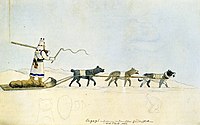Dog type



Dog types are broad categories of domestic dogs based on form, function, or style of work, lineage, or appearance. Some may be locally adapted dog types (or landraces) that may have the visual characteristics of a modern purebred dog. In contrast, modern dog breeds strictly adhere to long-established breed standards,[note 1] that began with documented foundation breeding stock sharing a common set of inheritable characteristics,[1][2] developed by long-established, reputable kennel clubs that recognize the dog as a purebred.
A "dog type" can be referred to broadly, as in gun dog, or more specifically, as in spaniel. Dogs raised and trained for a specific working ability rather than appearance may not closely resemble other dogs doing the same work, or any of the dogs of the analogous breed group of purebred dogs.[3]
Names in English
The earliest books in the English language to mention numbers of dog types are from the "Cynegetica" (hunting literature), namely, The Art of Venery (1327) by Twiti (Twici), a treatise that describes hunting with the
Almost 100 years later, another book in English, De Canibus Britannicus, by the author/physician
Dog types and modern breeds
"It is important", reminded
At the beginning of the 19th century, there were only a few dogs identified as breeds, but when
Other uses of the word '"type" in dogs
For biologists, a
Trainability and boldness
In 2011, a study found that
Notes
Note 1: ^ Every modern dog breed has a written "standard" that describes in detail aspects of its appearance. Modern breed standards are the basis of the sport of dog showing, as each dog is compared against the ideal of the written standard, and awards are based on how closely the dog resembles the standard. Their origin comes from the earliest European cynegetica: on a "sound hunting dog" see Xenophon, and the "correct type" of good sighthound, the vertragus, see Arrian.
Note 2: ^ Many modern breeds of dogs still use the names of early types, although they may or may not resemble the original types.
References
- ^ Webster's Third New International Dictionary of the English Language, Unabridged. The Merriam-Webster Editorial Staff. Springfield, MA U.S.A.: G&C Merriam Company. 1967. p. 274.
A breed is a group of domestic animals related through common ancestors and visibly similar in most characteristics, having been differentiated from others by human influence; a distinctive group of domesticated animals differentiated from the wild type under the influence of man, the sum of the progeny of a known and designated foundation stock without admixture of other blood.
{{cite book}}: CS1 maint: others (link) - ^ "Foundation Stock Service – American Kennel Club". American Kennel Club. 12 November 2017. Retrieved 16 September 2019.
- ^ McMasters, Jill. "The Functional Labrador". Retrieved 5 March 2008. also A forum that includes photos of the differences between conformation and working dogs of the same breed; and description of differences between show and field (working) Springer Spaniels Archived 30 June 2007 at the Wayback Machine
- ^ Twiti, William (1977). Danielsson, B.; Cynegetica Anglica (eds.). The Art of Hunting 1. Stockholm Studies in English XXXVII. Translated by Danielsson, B.; Cynegetica Anglica. Stockholm: Almqvist & Wiksell Int.
- ^ The Master of Game, by Edward, second Duke of York: ed. Baillie-Grohman, William.1st Ed. London: 1904 Ballantine, Hanson & Co Folio, 302pp. 52 pl
- ^ Edward, of Norwich; Baillie-Grohman, William A. (William Adolph); Baillie-Grohman, F. (Florence); Roosevelt, Theodore; Gaston III Phebus, Count of Foix (1 January 1909). The master of game : the oldest English book on hunting. London : Chatto & Windus.
- ^ "BNF – Le livre de chasse de Gaston Phebus". classes.bnf.fr. Retrieved 17 November 2016.
- ISBN 0-19-811715-9.
- ^ Berners, Juliana; Blades, William (1 January 1901). The boke of Saint Albans. London : Elliot Stock.
- ^ Caius, John; Gonville and Caius College; Royal College of Physicians of London; Roberts, E. S. (Ernest Stewart); Venn, John; Fleming, Abraham (1 January 1912). The works of John Caius, M.D., second founder of Gonville and Caius College and master of the college, 1559–1573. Cambridge, The University press.
- ISBN 0-87605-624-9.
In the strictest sense, dog breeds date back only to the last couple of decades of the nineteenth century, or to more recent decades in this (the twentieth) century but distinct types of dogs have existed centuries earlier.
- ISBN 0-684-85530-5.
- ISBN 0-87605-624-9.
In the strictest sense, dog breeds date back only to the last couple of decades of the nineteenth century, or to more recent decades in this (the twentieth) century but distinct types of dogs have existed centuries earlier.
- ISBN 0-87605-306-1.
- ^ The New Complete Scottish Terrier, pg. 17
- ^ 'DOGS, WORKING', from An Encyclopaedia of New Zealand, edited by A. H. McLintock, originally published in 1966. Te Ara – The Encyclopedia of New Zealand, updated 18 September 2007 URL: http://www.teara.govt.nz/1966/D/DogsWorking/en
- ^ The Merriam-Webster Editorial Staff, ed. (1967). Webster's Third New International Dictionary of the English Language, Unabridged. Springfield, MA U.S.A.: G&C Merriam Company. p. 2476.
qualities (as of bodily contour and carriage) that are felt to indicate excellence in members of a group <won the show with a beagle of superior ~>
- ISBN 0-684-82253-9.
typey: showing the breed characteristics to maximum effect
- .
